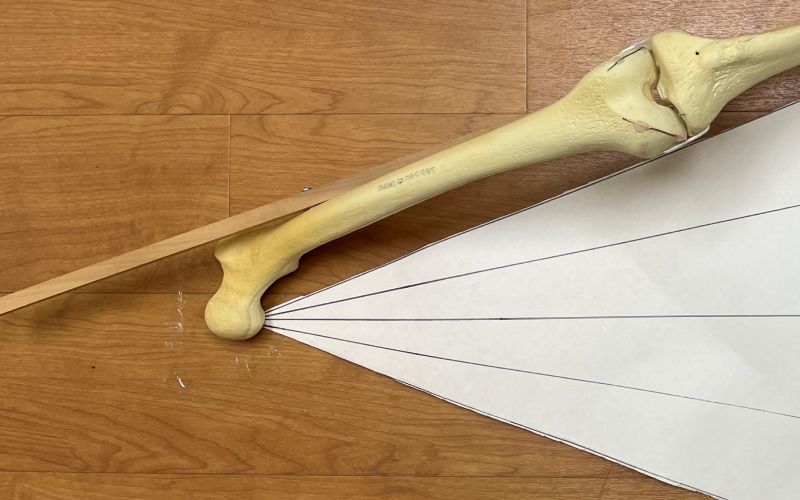Lateral knee radiographs used to measure the posterior tibial slope (PTS) are critical for physicians to formulate a treatment plan for knee injuries, especially if the injury involves a recurrent tear or may require revision of a prior anterior cruciate ligament (ACL) reconstruction. However, patients often come in with X-rays that have some amount of malalignment, leaving physicians to wonder if the PTS measurements are still valid.
“Most X-rays have a little bit of either rotation or abduction/adduction, where the condyles at the end of the femur are not lined up perfectly. The question was, well, how much is too much?” says Lauren H. Redler, MD, an orthopedic surgeon at NewYork-Presbyterian/Columbia.
Most X-rays have a little bit of either rotation or abduction/adduction, where the condyles at the end of the femur are not lined up perfectly. The question was, well, how much is too much?
— Dr. Lauren Redler
Dr. Redler says she often wrestles with whether to order new radiographic imaging, which can be inconvenient for patients and exposes them to additional radiation. There is little information in the scientific literature on how malalignment impacts the accuracy of PTS measurement and existing cutoffs are not evidence-based, she says.
Dr. Redler and her colleagues set out to address this issue by evaluating the impact of malalignment on PTS measurements and quantifying cutoffs that could be used by physicians in determining when new radiographic imaging is needed. The team used five sawbone models secured at knee flexion angles of 25° to 35° using a wooden dowel that was fastened by screws to the shaft of the femur and tibia. Metal wires outlined the medial and lateral femoral condyles and the medial tibial plateau, while an 18-gauge wire was used to outline the medial femoral condyle and a 22-gauge wire was used for the lateral femoral condyle.

The sawbone model fixed in 25° to 35° of knee flexion with 18-gauge wire outlining the medial femoral condyle, 22-gauge wire outlining the lateral femoral condyle, and 22-gauge wire outlining the medial tibial plateau to aid in measurements on radiographs. The positioning template shown aided in accurately obtaining images with the sawbone leg adducted (–5°, –10°, or –15°) or abducted (5°,10°, or 15°). A similar technique was used to obtain internal and external rotation x-rays.
They took 25 sets of radiographs showing knee malalignment at 5°, 10°, and 15° of each adduction, abduction, and internal and external rotation, as well as true lateral views for each set. Malalignment was quantified by measuring the anterior-posterior distance (APD) and proximal-distal distance (PDD) between the femoral condyles.
Overall, they found that the measured PTS was more sensitive to malalignment by abduction and adduction than by malrotation. The findings suggest that lateral radiographs can be used to measure the PTS if the PDD between the femoral condyles is less than 5 mm and the APD is less than 15 mm. The findings were published in Orthopaedic Journal of Sports Medicine.
“We found that the abduction and adduction was very limited in how much you could tolerate. You can only have five millimeters of overlap there; anything more threw off the accuracy of the measurement of the posterior tibial slope. But with rotation, if the condyles are perfectly superimposed and there was a distance between the posterior aspect of the femoral condyles, you could actually have up to 15 millimeters of that anterior-posterior distance and it doesn’t affect the accuracy of the measured posterior tibial slope,” Dr. Redler explains.
The findings, especially for rotation, came as a surprise to the research team, Dr. Redler says. “We were thinking that only the perfect lateral would give us the accurate slope. We were surprised that there was actually a little bit more leeway so that we could be more tolerant of some of these not so perfect X-rays,” she says.
We were thinking that only the perfect lateral would give us the accurate slope. We were surprised that there was actually a little bit more leeway so that we could be more tolerant of some of these not so perfect X-rays.
— Dr. Lauren Redler
The findings have the potential to reduce the number of patients who are sent back to radiology for unnecessary repeat X-rays because more radiographs are likely to be deemed acceptable using these new cutoffs.
“At the heart of it, it is better for patient care. They don’t necessarily need to go and repeat an X-ray and take the time and exposure to radiation, and we can make better informed decisions and be confident that those decisions are valid based on the information that we have on their imaging,” Dr. Redler says.
At the heart of it, it is better for patient care. They don’t necessarily need to go and repeat an X-ray and take the time and exposure to radiation, and we can make better informed decisions and be confident that those decisions are valid based on the information that we have on their imaging.
— Dr. Lauren Redler
But the study may have an even bigger impact on research, since currently patients can be excluded from studies if their radiographic imaging is not considered acceptable, she adds.
While the current findings only apply to PTS measurements, Dr. Redler says the success of the study prompted the team to begin looking at how abduction/adduction and rotation impact other measurements, such as patellar height measurements. The team has already launched a new study assessing patellar height measurements using a similar methodology, but with 3D modeling, rather than sawbone models. Dr. Redler says they have at least three to five ideas for additional studies that would help establish practical cutoffs for other measurements.
Studies like these would not be possible without the unique collaboration possible at NewYork-Presbyterian/Columbia. For this study, Dr. Redler and her colleagues worked closely with the Department of Radiology. “The collaborative nature of everyone that works at NewYork-Presbyterian is amazing and vital to the success of studies like this” Dr. Redler says.




